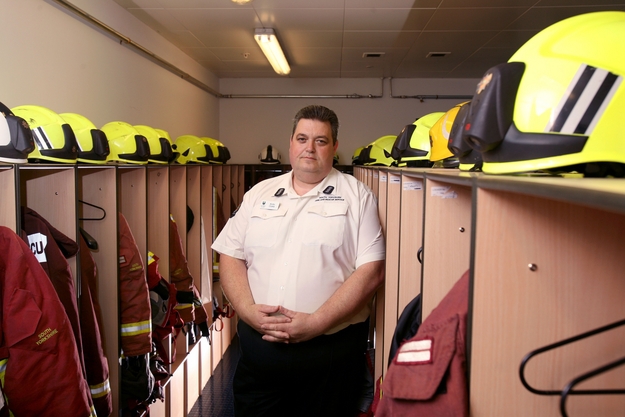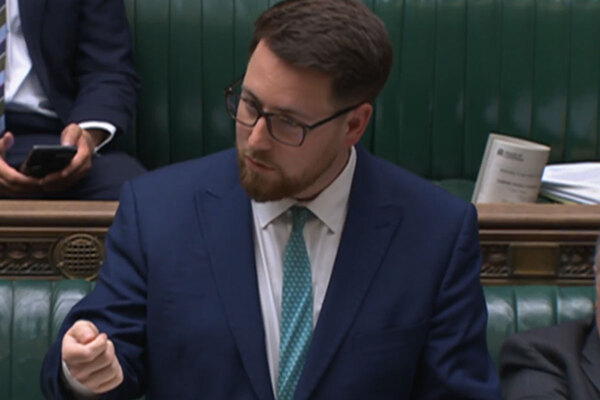In the line of fire
Since the Lakanal House fire which killed six people, Andy Cloke has made it his business to teach landlords how to prevent tower block blazes. Kicking off our fire safety special, he tells Martin Hilditch about the challenges he faces.

Andy Cloke is the self-styled ‘bad cop’ of the fire service. The south Yorkshire station manager, who leads on technical fire safety in his region, has earned his reputation in meetings with social landlords across the UK over the past 18 months.
Following the Lakanal House fire in Southwark in July 2009, which killed six people, the 50-year-old has travelled the length and breadth of the nation speaking to housing providers about fire safety in sessions organised by the Chartered Institute of Housing and the Chief Fire Officers’ Association.
The fire at Lakanal House in south London threw up a plethora of worries for housing providers. The fire spread much more quickly than anyone anticipated and it later emerged that a number of other tower blocks in Southwark were not covered by adequate fire risk assessments. The aim of the seven-stop tour was to highlight the work that can be done by social landlords to reduce the chance of a blaze.
Lessons learned
While Mr Cloke, who has worked for the fire service for 26 years, might have a genial, gag-a-minute personality he doesn’t pull any punches. At last month’s CIH conference, for example, he suggested some landlords’ fire risk assessments of tower blocks aren’t ‘worth the paper they are written on’ and said the fire service had signed off some ‘rubbish’ risk assessments in the past.
In light of these statements, Inside Housing meets Mr Cloke to find out what he thinks the fire service has learnt about tower block safety in the two years since the Lakanal fire and what action social landlords should be taking to make sure their tenants are not in danger.
Mr Cloke sits on a CFOA working group on technical fire safety, which devises policies and guidance for the UK Fire and Rescue Service. I meet him the day before he is due to sit down with industry representatives to help draft government-backed guidance on fire safety in tower blocks and he’s disarmingly honest about the fact that until the Lakanal blaze, tower block safety hadn’t really been on the radar for the fire service. ‘[In south Yorkshire] we had no serious tower block fires,’ he explains.
‘We had lots of information about high-risk, poorly managed premises, dating back to the beginning of the 1980s. The quality of information we had we felt was adequate to be able to recognise where our high risk was. That is why we didn’t have any audits in tower blocks.’
This is despite the fact that under the Regulatory Reform (Fire Safety) Order 2005, which came into force in October 2006, landlords are responsible for risk assessing their stock and fire authorities must ensure the checks they have carried out are adequate.
The main reason for the oversight on his own patch, says Mr Cloke, was that it had never had any major incidents to deal with. This changed almost immediately following the Lakanal tragedy. A series of freedom of information requests from Inside Housing - part of its Safe as Houses campaign to improve fire safety - revealed that many fire services stepped up checks on tower blocks following Lakanal. South Yorkshire was one of them. ‘The two authorities with the most high-rises were Sheffield and Doncaster, so that is where we concentrated our efforts. Once we started to have a look, you could see there were issues that needed to be addressed,’ Mr Cloke explains.
Common ground
When it began investigating, the fire service saw a common problem in some blocks. The main issue was that fire protection designed to stop flames spreading between different floors and flats - known as compartmentation - had been compromised. This means a fire could, in the right conditions, spread more quickly than anticipated putting residents’ and firefighters’ lives in danger.
Like many landlords, Sheffield and Doncaster had been part of the government’s decent homes programme, which saw an estimated £19 billion to £37 billion spent improving tenants’ homes across England over the past decade. Ironically, it appears some of this work could have actually increased the danger of a fire spreading.
‘What you found was that in kitchens and bathrooms, which is where the majority of the work had been done, that [compartmentation] had been undermined,’ Mr Cloke explains. ‘So it [smoke/fire] could [potentially] travel up and go into the next kitchen. It was all a case of landlords thinking they were doing the right thing but taking their eye off the ball on certain [other] things.’
He says the potential for a blaze to spread could be increased by something as simple as a plumber installing a pipe and not sealing it properly - creating a gap that fire could spread through. ‘All you need is a plumber saying “let’s get this done quickly and then I’m off early”,’ he states.
A joint effort
Gary Lund, health and safety manager at Sheffield Homes, has known Mr Cloke for nearly two years. ‘He’s got a wealth of knowledge and has been more than helpful,’ he says.
The 42,000-home arm’s-length management organisation has been working with Mr Cloke and his technical team on its fire risk assessments since August 2009. At first, Mr Lund admits, the south Yorkshire manager wasn’t very impressed with the housing provider’s documentation. ‘It only covered communal areas of the building,’ he explains. ‘Andy asked, “What if a fire occurred behind closed doors?”.’
‘The relationship between us has been frank, open and challenging, and Andy has pointed us in the right direction,’ Mr Lund explains.
The work Sheffield Homes has done under Mr Cloke’s guidance has paid off. There have been two fires in its properties this year, and thanks to the safety measures put in place, both were contained within the area in which they broke out.
The born and bred Yorkshireman himself is at pains to state that relationships like the one he has with Sheffield Homes - a strong working arrangement between housing provider and local fire service - are constructive. However, Mr Cloke acknowledges that spending the best part of 18 months telling landlords they might have a problem has not always endeared him to everyone.
Yet it is clear that landlords still face major issues in coming to terms with the issues raised by the Lakanal tragedy. Results of a survey completed by almost 400 housing professionals during Mr Cloke’s tour of the UK make alarming reading. Just 25 per cent of those polled thought they had carried out ‘suitable and sufficient’ fire risk assessments of their tower blocks after listening to the best practice information presented in the sessions. Nearly half said they were not confident that the people carrying out their risk assessments were ‘wholly competent’ (Inside Housing, 1 July).
Different strokes
‘The people I speak to would love for me to be able to pull a rabbit out of the top hat and say “this is the perfect risk assessment”,’ Mr Cloke states. ‘But every situation is different.’
The difficulty arises because it is impossible to ever make a tower block 100 per cent safe, he states. Risk assessments should do exactly what it says on the tin - identify potential problems, work out how significant they are and set out how they will be either managed or eradicated.
But if there isn’t a one-size-fits-all solution, Mr Cloke is very clear about the types of approach that should be avoided. For starters, he is scathing about some consultants he states have come up with tick-box risk assessments. ‘They do not contain enough information about the decision-making process behind the documents,’ he explains. Providers should avoid this kind of risk assessment because, in the worst cases, it can mean they avoid thinking about levels of fire risk in enough detail. ‘With some of these contracts you get a lot of standard phraseology,’ he states contemptuously. ‘It is cut and paste.’
Mr Cloke is passionate about his job - when he goes shopping with his wife, he tends to look at escape routes and fire protection while she looks in the shop windows, he admits.
He’s also willing to put himself out to help landlords improve their fire safety performance. Our hour-long interview slot stretches to two-and-a-half hours, so keen is he to talk about the work landlords can do.
There is no ready-made answer for housing providers - Mr Cloke, is however, able to present one very fundamental question that he says landlords should always ask themselves in drawing up their risk assessments. ‘Am I able to live with that?’
Andy Cloke on stay-put policies
The Lakanal fire started a debate among social landlords as to whether they should evacuate tenants if a fire breaks out or leave them in their homes. This is a hugely sensitive issue because the fire service is alleged to have told people to remain in their properties during the Southwark blaze, as the fire should have been contained on one level if compartmentation had worked properly.
During the seminars which Andy Cloke, the south Yorkshire station manager who leads on technical fire safety in his region, has attended over the past 18 months, housing providers said they still felt uncomfortable and unsure about which policy - evacuation or stay put - they should adopt.
The confusion is demonstrated in the Chartered Institute of Housing and the Chief Fire Officers’ Association’s fire safety guidance, published last month. It includes advice from an environmental health officer saying that ‘if a building is fitted with a sprinkler system then a stay-put policy may be considered subject to a full fire safety risk assessment. In all other cases we would recommend evacuation of the residents’.
However, this is shown to contradict draft government-backed guidance issued earlier this year which recommended that - subject to any issues identified in a fire risk assessment - stay put was the most appropriate response.
‘The problem is that a stay-put policy is the right thing to have,’ Mr Cloke states. ‘It is better than trying to get everyone out all at once.’
If everyone is evacuated while the fire service is trying to gain access to a building it can slow their ability to tackle a blaze and rescue people who may be trapped in the area where the blaze has broken out, he suggests. ‘You have to make a judgement,’ he adds.
Mr Cloke is very keen that landlords make the judgement themselves. Hiring in consultants might seem attractive but it can mean that staff do not engage with the issues in any great depth themselves, he states.
‘The other thing that riles me in risk assessments is [lines that say] “check with the fire service that they are happy with a stay-put policy”,’ he adds. ‘It is not down to us. It is down to [the fire risk assessor] to tell us. For us to be able to do that, we’ve got to do the same thing the fire risk assessor should have done in the first place.’









